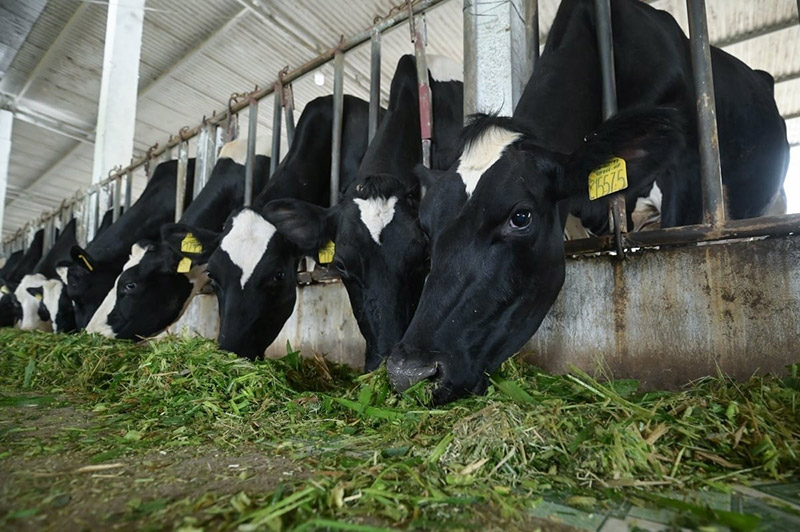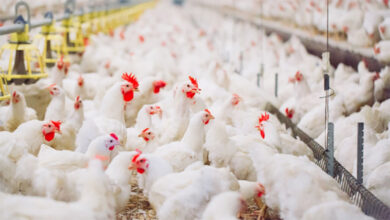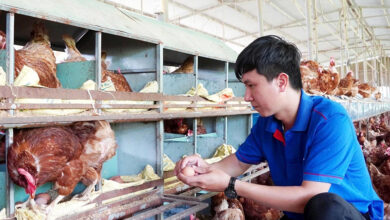Warning of decline in Vietnam dairy farming

According to the Animal Husbandry Association of Vietnam, the dairy market is overheating, with massive imports of milk materials, while more alarmingly, the growth rate of domestic dairy herds has plummeted.
The Animal Husbandry Association of Vietnam (AHAV) has recently submitted a document to the Ministry of Industry and Trade, the Ministry of Agriculture and Environment, and the Ministry of Health, highlighting the alarming decline in domestic dairy farming areas, which directly affects the livelihoods of millions of farmers.
According to AHAV, the national dairy development program for the 2000 – 2020 period had demonstrated Vietnam’s capability to develop a dairy farming and processing industry based on domestic raw material sources through its own methods and approaches.

Vietnam has the full potential to develop a dairy farming and processing industry. Photo: Tung Dinh.
The harmonious combination of concentrated farming at large companies and household farming enabled Vietnam’s dairy herd and fresh milk output to maintain strong double-digit annual growth, ranking first in the region. This dual model achieved multiple goals: supplying consumers with high-quality fresh milk and contributing significantly to the development of the domestic livestock industry, paving the way for Vietnam to establish a fast-growing and sustainable dairy industry in the region.
However, in recent years, the Vietnamese dairy market has overheated, with an explosion of brands, milk, and dairy products, alongside massive imports of milk materials that have disturbed the market and overwhelmed domestic sources. As a result, consumers face difficulty in identifying which products truly meet quality standards.
More critically, the growth rate of domestic dairy herds has plummeted, particularly among smallholder farms. Traditional dairy farming areas, such as Ho Chi Minh City, Ba Vi, and Moc Chau, are on the brink of collapse. In Ho Chi Minh City alone, the dairy herd has decreased by over 50%.
The AHAV’s report pointed out that after a strong double-digit growth period of 15.4%/year from 2010 to 2015, the national dairy herd slowed drastically to just 1.9%/year from 2015 to 2020 and further declined to 0.4%/year during the 2020 to 2024 period.
This decline makes it impossible to meet the targets of the Livestock Development Strategy, which aimed for a national herd size of about 500,000 dairy cows by 2025. In reality, the herd currently stands at only 330,000 heads, or 65% of the target. Without timely adjustments, the 2030 plan of reaching 650,000–670,000 dairy will be unattainable.
Similarly, the annual growth rate of fresh milk production has sharply decreased, from 17.7% in the 2010–2015 period to 6.7% in the 2015–2020 period and to only 3.3% in the 2020–2024 period.
If timely adjustments are not made, Vietnam will fail to achieve the 2030 target of producing 2.6–2.8 million tons of fresh milk, ensuring per capita consumption of 25–26 kilograms, and meeting the strategic goal of 60% self-sufficiency in raw materials for the dairy industry.
AHAV has recommended that the rapid decline of household dairy herds be thoroughly reviewed and evaluated to find solutions for their recovery.
According to AHAV, Vietnam needs to develop its dairy herd through two approaches to sustain herd size and protect its domestic milk market share, which are high-intensity concentrated farming as practiced by major corporations and professional household farming with herd sizes ranging from 20 to 100 heads/household, ideally 30-50 heads/household. The latter model is considered highly effective, as it makes use of the diligent rural labor force and the abundant source of byproducts in the agricultural and processing industries in Vietnam, which are not commonly found in other countries.
The management of milk and dairy product production and trade must be reassessed in a systematic and responsible manner to ensure long-term development and create favorable conditions for producers and businesses. This business sector requires not only strict adherence to the law but also ethical standards and community responsibility toward consumers and domestic farmers, who remain the most vulnerable actors in this special value chain.
To ensure that Vietnam develops a sustainable dairy industry in line with the objectives of the Vietnam Dairy Development Strategy for the 2025–2030 period, with a vision to 2045, currently being finalized by the Ministry of Industry and Trade for submission to the Prime Minister, AHAV has proposed that relevant Ministries adopt a unified stance and solutions around several key issues:
1. Vietnam’s dairy industry must capitalize on the country’s strengths, particularly fresh milk and the diverse supply of tropical agricultural raw materials and additives, while minimizing imports of raw materials that can be produced domestically.
2. School milk programs using fresh milk products must be developed, following the successful models of many countries worldwide. Such programs not only provide children with optimal nutrition but also drive the growth of the domestic livestock industry. Vietnam’s potential in livestock for milk production fully meets these requirements.
3. Technical standards and regulations need to be completed to ensure transparency, clarity, and easy differentiation among milk and dairy products, especially between fresh milk and reconstituted milk (milk powder mixed with water). This will enable consumers to make choices while guiding producers, traders, and management agencies in their implementation.
4. Regulations should require dairy producers and traders to either establish or be linked with domestic raw milk production areas or to use a minimum percentage of locally produced fresh milk. Although fresh milk offers the most benefits to consumers, it yields the lowest profit for businesses. Therefore, even in countries with less developed dairy industries, such as India, Indonesia, the Philippines, Thailand, and China, such regulations are in place. For instance, the Philippines’ Republic Act No. 7884 (National Dairy Development Act of 1995), Section 17, requires commercial dairy processors and traders to purchase at least 5% of their raw fresh milk from domestic sources. Businesses exceeding this minimum are entitled to credit or tax incentives worth 10% of the additional local purchases.
AHAV has suggested the Minister of Industry and Trade, the Minister of Agriculture and Environment, and the Minister of Health direct functional agencies to unify their perspectives and measures for the comprehensive development of Vietnam’s dairy industry. This should be carried out in the process of formulating strategies, policies, and legal frameworks for the implementation of the Vietnam Dairy Development Strategy, ensuring sustainable growth with the ultimate goal of safeguarding public health and strengthening domestic production.
Vietnam’s dairy productivity leads the region
In contrast to the declining herd size and milk output, the productivity of Vietnam’s dairy cows has risen sharply. Average milk yield increased from about 5 tons/head/cycle during 2010–2015 to over 7 tons/head/cycle in 2020–2024, which is an extremely fast growth rate rarely seen elsewhere. With this average yield across the total herd, Vietnam has now become the country with the highest dairy productivity in the region.
There are two main reasons behind this rapid rise in productivity:
(i) Breeding quality, particularly the rapidly growing proportion of purebred, high-productivity dairy cows, combined with nutrition regimes and intensive herd management. These practices have unlocked the full genetic potential of dairy breeds within farm- and industry-scale livestock areas run by major corporations such as TH true MILK and Vinamilk.
(ii) The proportion of dairy cows raised in concentrated, intensive farming systems by companies and corporations is increasing, while the number of household-raised dairy cows has declined rapidly, especially around Ho Chi Minh City, which once accounted for more than 60% of the national dairy herd.
The average number of dairy cows per 1,000 people in Vietnam remains very low: just 3.3 heads per 1,000 people, only one-third that of Thailand and Japan, nearly half of South Korea, one-quarter of Israel, and just 1/26 of the Netherlands.
Yet, in terms of natural conditions and socio-economic potential, Vietnam today has greater capacity for dairy livestock farming than Japan and Israel. The country could potentially expand its dairy herd by 4-5 times the current level by the 2030s, reaching 1.3–1.5 million cows, with raw fresh milk output of 4.3–5.0 million tons.
(Animal Husbandry Association of Vietnam)





